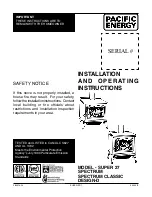
AES Technical Bulletin #T-0068 Date of Issue 06/22/2007
Over drafting on a vertical install
- If the install is using an existing chimney it is important to
run the appropriate liner for the stove. The auger trim may have to be adjusted in order to
maintain the pilot fire.
Positive or negative pressure of the home
- Pressure in the home will cause inconsistent
drafting of the stove. This can cause the fuel to burn up too quickly, or not fast enough
causing the stove to shut down.
Dirty fuel
- Pieces of cob, stalk, or leaves will cause the corn to get hung up and not drop into
the firepot consistently causing the fire to burn itself out.
10.
Foreign object caught in the auger and will not turn.
An object has gotten into the hopper and caused the auger to stop turning
- Remove object by
relaxing tension on the auger. DO NOT try to remove the object by hitting, or prying on it!
To release tension on the motor, loosen set screw and remove the auger motor. The other
option is to remove the auger motor stop bolt. On DC models it is possible to switch the
wires leading to the motor, this will cause the motor to turn in the opposite direction.
Depending on the damage done to the auger it might be necessary to lightly buff down any
burrs or rough areas.
11.
The stove is generating too much ash.
Ash is directly related to quality of fuel, stove efficiency, operation, and install. All solid
burning appliances generate ash to a certain degree depending on the factors listed earlier.
The following are areas that should be looked at in order to help reduce the amount of ash
generated by the stoves.
Dirty fuel
- Run the fuel through a screener to remove fines and other debris. Because of the
air flow going through the firepot most of the fines don’t even get burned, they end up as ash
on the inside of the stove and have no heat value whatsoever.
Wet fuel
- Only burn fuel that is at the appropriate moisture levels mentioned in the owner’s
manuals. Store fuels in proper containers and bring the fuel up to room temperature before
dumping into the stove. Burning wet fuel causes incomplete combustion and may cause the
stove to create a “creosote” like coating inside the burn chamber and exhaust system.
Lack of clean combustion air
- Be sure to check the surrounding area where the fresh air
intake terminates. Stay away from clothes dryers, water heater terminations, or any other
item that may cause the fumes to get sucked back into the stove.
Dirty or plugged stove/venting
- Make sure to perform the suggested maintenance instructions
on the schedule listed in the owner’s manual.
Combustion blower going out
- Check amp draw, voltage, continuity, and ohms for the draft
blower.
Use combustion enhancement system
- The CES is designed to re-direct some of the ash back
to fire pot when it would otherwise be blown out of the fire pot. The CES also increases the
overall efficiency of the stove. The one drawback is that it blocks part of the view of the
flame, which most homeowners enjoy.
Air intake is too close to the exhaust
- Make sure to observe proper clearances when installing
the venting. Drawing in exhaust fumes will cause the stove to lose clean combustion air and
burn dirty.
12.
The heat output is not as high as when the unit was installed.
























